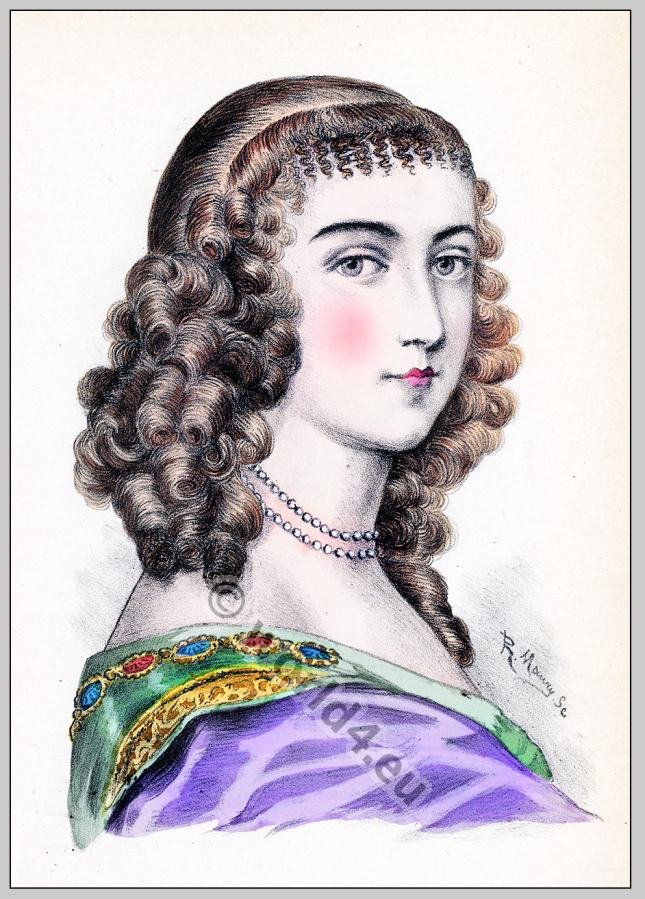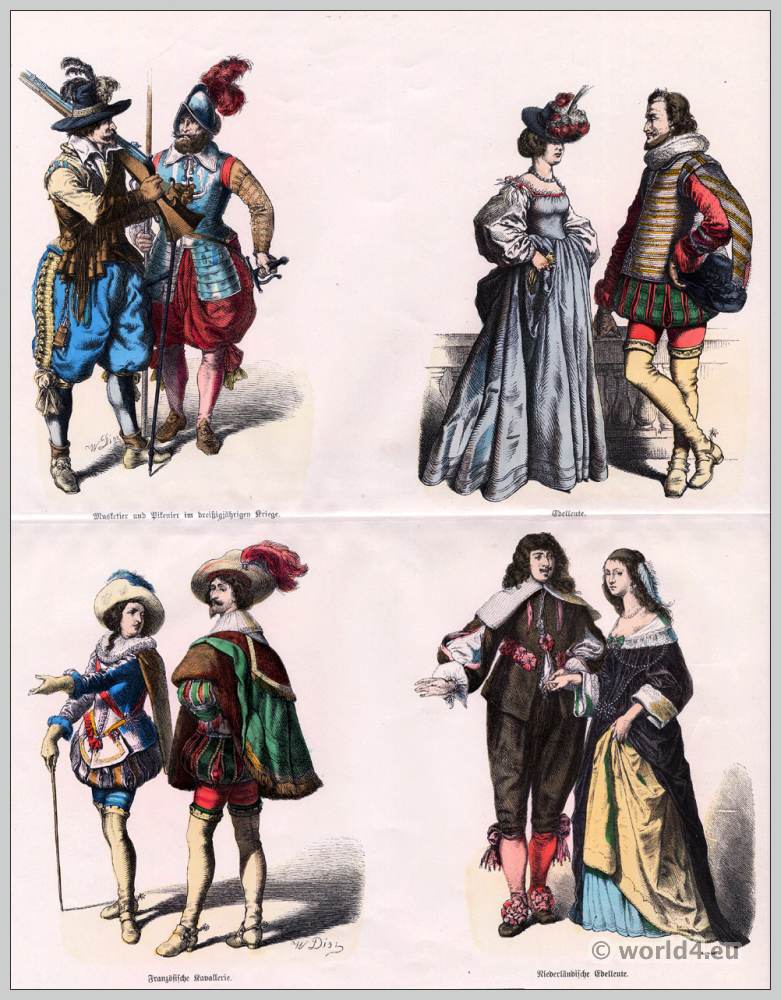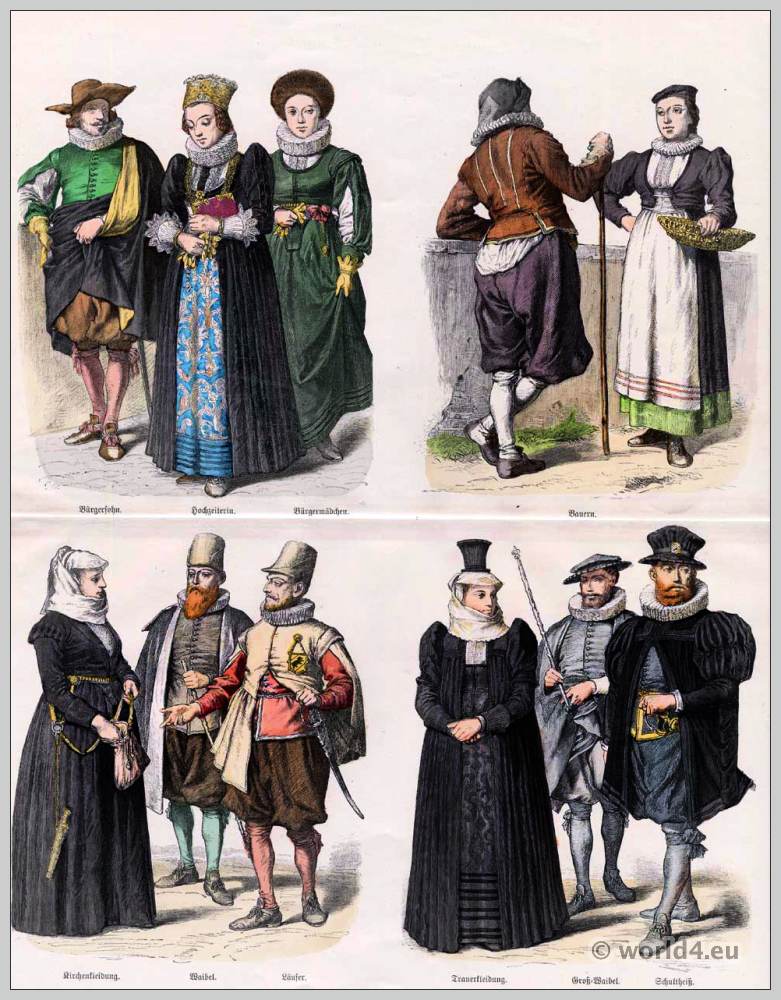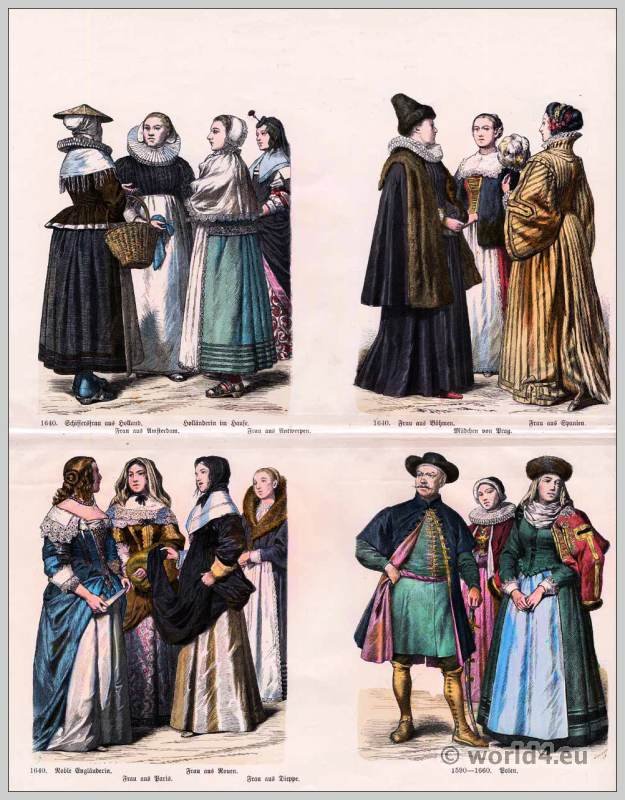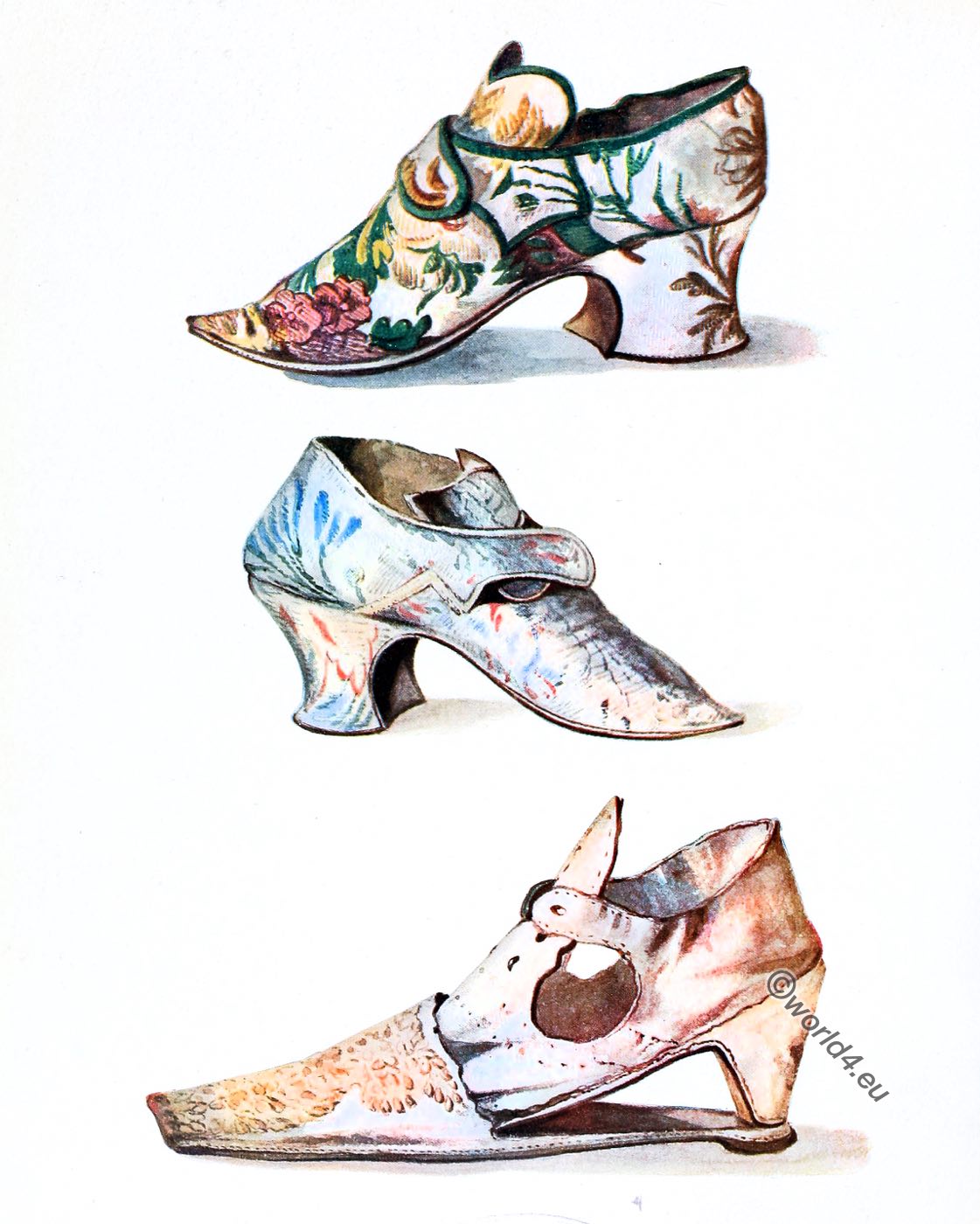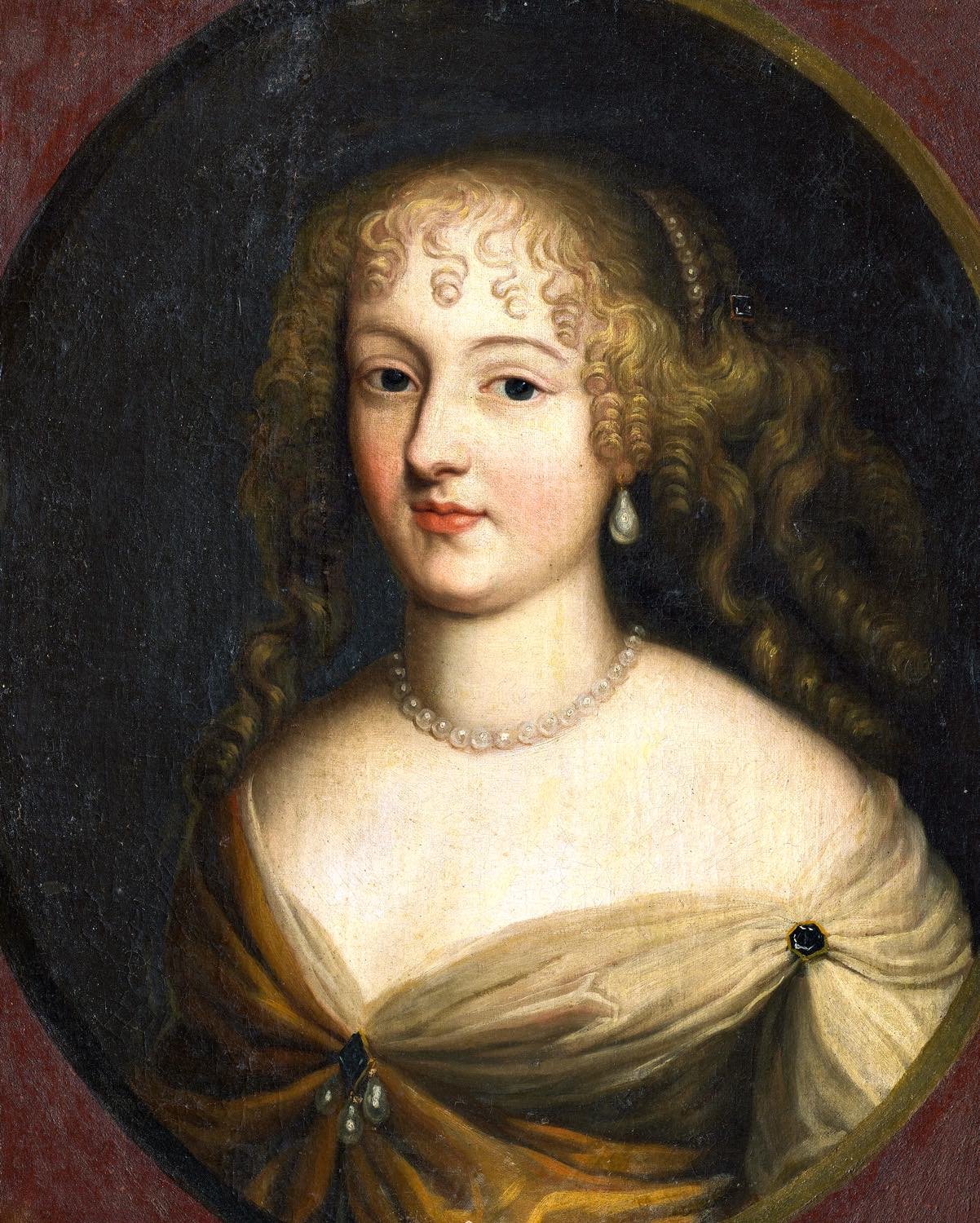
Anonymous (France)
Collection: Château de Bussy-Rabutin – Anne, dite Ninon de Lenclos
Anne “Ninon” de l’Enclos also spelled Ninon de Lenclos 1620-1705.
Ninon de L’Enclos was a French liberal and educated intellectual, feminist, writer (La coquette vengée “The Flirt Avenged”) and lover of many also famous contemporaries. She was one of the outstanding women of the ancien regime, the participation in their Jours was a great society honor. She was considered at the court of Louis XIV as a master of witty conversation.
To their friends included Queen Christina of Sweden, Madame de Maintenon (Françoise d’Aubigné, marquise de Maintenon, the second wife of Louis XIV), Molière and Madame de Sévigné.
Ninon de Lenclos put value on their independence: She never married and had countless lovers. Even as octogenarian, it is said, had they been sought after by men. They even took their Caprices, as she described her love affairs, not very serious and never got involved in a serious relationship with a man. She emphasises that “to make us happy, love must not be conceived as a serious affair, but as a light and cheerful thing.” The children resulting from their liaisons, they left it to the respective fathers for education because they did not want to burden them with child care. One of her children fell unsuspectingly into it, even though she was already 60 years old. She revealed to him that she was the mother. Then he shot himself before their eyes.
“Ninon, who had served love for almost a whole century, finally ended her days. She was at once the honour and the shame of her sex,” writes Abbé de Châteauneuf. She was “faithful and wise to her friends, tender and flighty to her lovers”. When the French courtesan Ninon de Lenclos died on 17 October 1705, there was sincere mourning in Paris.
Shadows of old Paris. Ninon de Lenclos. (excerpt)
by Georges Duval
Anne de Lenclos was born in Paris, in 1620. She was the only daughter of a gentleman of Touraine, who served in the suite of the Duc d’Elbeuf. Monsieur de Lenclos was obliged to leave France, shortly after Ninon’s birth, having killed the Baron de Chabans in a duel, which savored somewhat of an assassination, for Chabans had pot put up his guard before Lenclos ran him through the body. Henri de Lenclos was a jolly gentleman, with mot too much morality, nor too many scruples, whose chief aim in life was pleasure.
Madame de Lenclos, on the contrary, was a woman of great piety. She educated the young daughter left under her sole care and direction, according to the custom of that day, which consisted in giving her a complete knowledge of the Prayer Book, the Lives of the Martyrs, and a deportment suitable to her rank as a gentlewoman. Mademoiselle de Lenclos was most accomplished in the intricate measures of the formal dances then in vogue. She sang and played the lute, wrote more or less correctly (a person of quality was not required to spell) and possessed, above all, to crown her accomplishments, a beautiful face and figure, and a particular grace of manner.
The quarter of the town which Madame de Lenclos inhabited was one of the most fashionable, as it was also one of the most “gallant” in Paris. Ninon lived surrounded by examples that hardly tended to cultivate austerity. Such a charmer was bound not to pass long unnoticed, and, at the age of fifteen, Mademoiselle de Lenclos had already a host of admirers. Her choice lighted on Charles de Beaumont, Sieur de St. Etienne. Madame de Lenclos, thinking the gallant was a possible husband, encouraged his visits and assiduities. But Ninon was as little inclined for matrimony as St. Etienne himself. After a brief idyl, each went their way. Ninon’s was to the arms of the Chevalier de Raray. One day, when, during the absence of her mother, she was talking to her lover before the door, a beggar, whining for alms, planted himself near the couple. Nothing would induce him to leave the young people alone, though they had not a penny in their pockets. “Here,” cried Ninon, throwing him her Lace pocket handkerchief, “take this and sell it, but, at least, leave us in peace!” Mademoiselle de Lenclos had begun her career!
It was hardly possible to remain longer under Madame de Lenclos’ pious roof, notwithstanding the toleration of the customs of that time. Ninon moved to a house of her own, Rue des Trois Pavillons (now Rue Elzévir). To those who did not please her, she was inexorable, whatever the advantages they offered; to those who half pleased her, she would say, “I can promise you nothing. Await my caprice, if you choose.” With those who pleased her wholly, she herself took the initiative.
Mademoiselle de Lenclos was not venal, and she had the rare quality of sincerity. Her admirers were divided into two categories, known as the “favourites” and the “martyrs.” Her rule in life, if she acknowledged any rule, was never to give the slightest favor to those who left her heart untouched-true, that Ninon’s heart was easily won, and she counted her adorers by the dozen. When she tired, she would tell her admirers that as she had had enough of them, they must seek good fortune elsewhere.
Yet, in ceasing to be a mistress, she remained a loyal and devoted friend. “I think I shall love you for three months,” she said to Rambouillet, and, when he chid her for fixing so short a limit, “My dear,” she answered, “for me it is an eternity.” All the town crowded to Mademoiselle de Lenclos’ house. During Lent she held open table, and, contrary to the custom in all classes, meat was served daily to her guests. One of them got his hostess into disgrace by throwing a bone out of the window, which unluckily fell on the head of the priest of Saint-Sulpice, who was passing. Ninon received a visit from the authorities, and it required all the influence of her friends to protect her from the ire of the Church and the punishment of the Law.
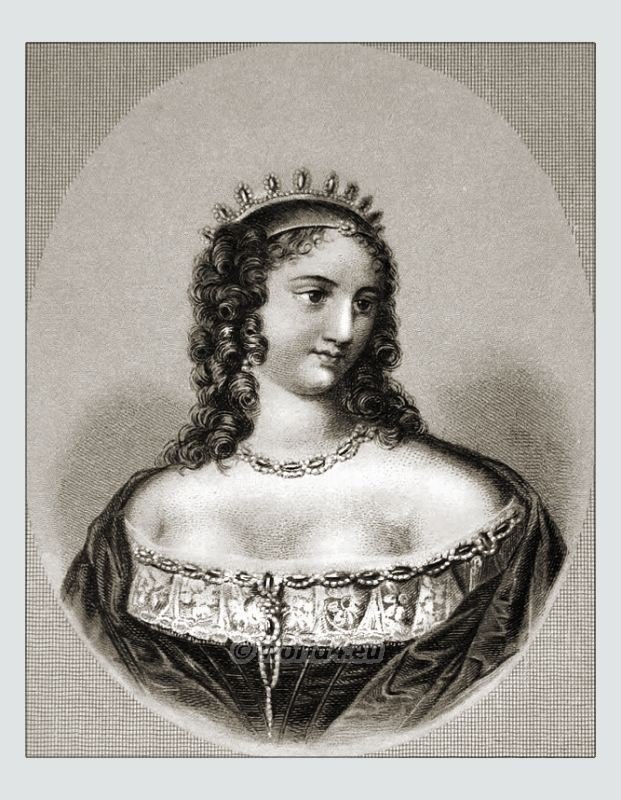
Mademoiselle de Lenclos’ lovers were amongst the highest in the kingdom; her love affairs, her witticisms, her beauty, were the topic of Court and town. In the young Duc d’Enghien, she perhaps recognized the future conqueror, Le Grand Conde, though she said that “it required a hundred times more wit to make love than to lead an army.” Richelieu did not please her, and she would have none of him. He never forgave her.
She considered that he who would love must be rather the master than the slave of passion, and she invariably left her lovers before they had time to tire, or even to grow accustomed. Ninon regarded love as the first of all arts, and certainly, in her profession, she was a great artist. She was the cause of more than one fatal duel; but she did not reproach herself, having always told her lovers that shc would be faithful only while her fancy lasted, which was never long. Ninon’s motto was, “Be inconstant as long as you can, for the times comes when you can no longer be so.” Some of La Rochefoucauld’s maxims on love were, perhaps, inspired by Ninon, for he was one of her assiduous frequenters.
Mademoiselle de Lenclos, though already about forty years old, was as yet untouched by the hand of time, when she had the good, or rather ill-fortune, to meet Villarceaux. He was to give her heart the only lesson in fidelity that it ever acknowledged. He united physical advantages with a lively intelligence; his jealous disposition was a perpetual burning of incense on the altar of love. He was the sincerest passion of Ninon’s life. She left the adulation of a whole population to live with him in the seclusion of the country, where for three years she exiled herself from friends, admirers, and pleasures, He was a jealous lover, and, to appease him one day. when he was ill, she cut off her magnificent hair and sent it to him as an offering.
It was the one occasion, in her career in which she was wanting in science; she revealed the secret, that a woman should always keep from the man she loves-that he was indispensable to her. Villarceaux was the first to tire. After such a long period of fidelity, Ninon threw herself into a vortex of folly, which ended by exciting the ire of the Queen Mother, although Anne of Austria, more than any other, should have forgiven those who listened rather to the promptings of their hearts than of their heads. Perhaps Madame de Villarceaux had influenced the Queen; she was desperately in love with her husband, and jealous of Ninon.
It was with small enthusiasm that Mademoiselle de Lenclos received the Queen’s order to retire to a convent. The person, who bore the letter, suggested that she should choose the “Repentant Sisters,” as the Queen had left her free to go where she liked. “I am neither a sister, nor repentant,” she answered when she was sent to “les Madelonnettes.” The authorities were obliged to have a guard to surround the convent, as the army of Ninon’s admirers swore they would destroy it to liberate her; she was therefore moved to Lagny. On her visit to France, Queen Christina of Sweden expressed a desire to see the celebrated beauty. They had an admirer in common, the Maréchal d’Albret, who had sung Ninon’s praises, and it was he who arranged the interview which lasted for some hours.
In the bibliothéque de l’Institut, there is a memorial of the entry of the Swedish Queen into the City of Paris, and of her sojourn there. The author informs us “that Christina separated from Mademoiselle de Lenclos with such admiration and esteem for the fine quality of her intelligence, that she immediately wrote to the King, Louis XIV., requesting him to liberate her and recommending his Majesty to send for Ninon, as he would certainly find great diversion and profit in her society.” The request was acceded to, and, although she was not called to Court, Ninon was allowed to return to her house, in the Rue des Tournelles 1), where she received her numerous Visitors in the famous yellow room, from which she wrote, one dan to St. Evremond that “she thanked God every night for her wit, and prayed to Him every morning to preserve her from the follies of her heart.” Ninon’s salon, if not one of the most prudish, was one of the most brilliant and exclusive of the town. The best tone prevailed, and the first statesmen, nobles, and poets gathered round the bewitching woman, who, if no longer in the spring of life, had retained nll the fire of youth, and gained all the savour of maturity. Her charm was of that quality which, knowing no age, pervades, like a delicate perfume, the atmosphere around the woman who possesses it.
1) No. 36: It was built in 1642 for the prosecutor of the Châtelet, Louis du Baille, and sold to Ninon de Lenclos in 1684.
Amongst the most assiduous frequenters of Mlle. de Lenclos’ salon was the Poet Paul Scarron (écuyer et seigneur de Fougerest, Beauvais et La Rivière, a.k.a. Monsieur Scarron). On Ninon’s return from her enforced seclusion, she found that Scarron had taken a fair young bride, Mlle. Françoise d’Aubigné. Scarron had said of his wife: “I will not ask her to commit follies, but I can teach them to her.” Ninon also undertook the education of the future Madame de Maintenon, while Villarceaux, the charmer, laid siege to her heart. She did not remain insensible to his courtship; they met in the yellow room, which Ninon complacently placed at their disposal. But Mlle. de Lenclos found her pupil somewhat unsatisfactory. “In her youth,” she says later, writing of the Marquise de Maintenon, “she was virtuous by weakness; I should have liked to cure her, but she was too Godfearing.”
Meanwhile, Monsieur de Lenclos had returned to France after his long exile. He found his daughter at the climax of her career, nor was his pride in her diminished by the various incidents of her adventurous existence. But Henri de Lenclos was not troubled by unnecessary scruples. His chief aim in life had been enjoyment, and he appreciated the same taste in his daughter. When a sudden malady interrupted the current of his peaceful life, he felt that his end was approaching, and sent for Ninon. “My child,” he called to her feebly, as she entered his room, “My child, the only regret I carry away with me is that of the enjoyment which I must leave behind. You, who remain, be rather scrupulous in the choice than the number of your pleasures,” and, with these words on his lips, Ninon’s father died.
Saint Evremond said of Ninon that, “Nature had wished to show that it is impossible to become old.” One of her lovers, at this time, was the son of that Marquise de Sévigné, who had died in a duel, for her sake, twenty years before. Madame de Sévigné is hardly indulgent to Ninon in her Correspondence, but she is forced to admit a wit that was undoubted, and she agrees as to the refinement and perfection of her manners. To frequent Mlle. de Lenclos was considered a liberal education for the young men of the day. A course with her was the finishing touch in the forming of a courtier.
At sixty, she still inspired passions. Ninon had had a son by Monsieur de Gersay, The Chevalier de Villiers was ignorant of his origin, as he had been educated by his father. Like all young men of fashion, he was taken one day to be introduced to Mlle. de Lenclos, with the result that he fell in love with her. To cure his passion, Ninon revealed her identity, and the unhappy Chevalier killed himself. Perhaps such an adventure did much towards calming her coquetry. “Madame,” the Regent’s mother, writing about this time to the Duchess de Hanovre, says: ” Since Mlle. de Lenclos has begun to grow old, she leads an absolutely irreproachable life. It seems that she says that she would never have reformed, if she had not found that, at her age, love becomes ridiculous. Her admirers were known as “Oiseaux des Tournelles.” At seventy-nine, she inspired her last passion in the breast of l’Abbé Gedoyn.
At eighty-five Ninon’s friends found her failing. Her health was not what it had been; her dreams were haunted at nights by a little man in black, who had always fore-warned her of the momentous events of her life, and she attached great importance to his visits. If not religious, Ninon, like most of the women of her time, was superstitious; L’abbé Teste undertook her conversion. “He believes it will gain him great credit and an abbaye,” she wrote, “but I am afraid, if he counts on my soul, he will die without honors.” The Abbé gave up his hopes of gaining a proselyte in one who had put all the force of her mind and body, for three-quarters of a ‘century, into the science of living joyously. “Mademoiselle,”” he cried in despair, “in waiting your conversion, at least offer a sacrifice of your incredulity to God.”
It was in her house, in the Rue de Tournelles, that Mlle. de Lenclos passed her declining years. Here, one day, a lad of thirteen was brought by his godfather, M. Arouet, who was Ninon’s notary. The young scholar pleased the great courtesan; she, who was no mean judge of men, divined the future Voltaire in the shy schoolboy. On his side, Voltaire never forgot her. He had been told the legend of the celebrated beauty, and was surprised to find only a shrivelled old lady, who frightened him by her big eyes and her questions. In her will, Ninon left the young Voltaire a legacy with which to buy books.
The 15th of October, 1705, as Ninon slept, her sombre visitor reappeared three times, and pointed with a warning finger. She judged that his premonition was definitive, and sent for her friends. They called for the priest to come and administer the last sacraments, but when he arrived, it was too late! Ninon’s rebellious heart had already fled to regions of perpetual youth.
Fifty years later, the Court ladies adopted the fashion of keeping a skull, with a lamp burning in it, in their oratories. The Queen Marie Leszczyńska had one decorated with ribbons, which she called “la belle mignonne.” It was supposed to be the skull of Ninon de Lenclos. To such complexion had she come at last.
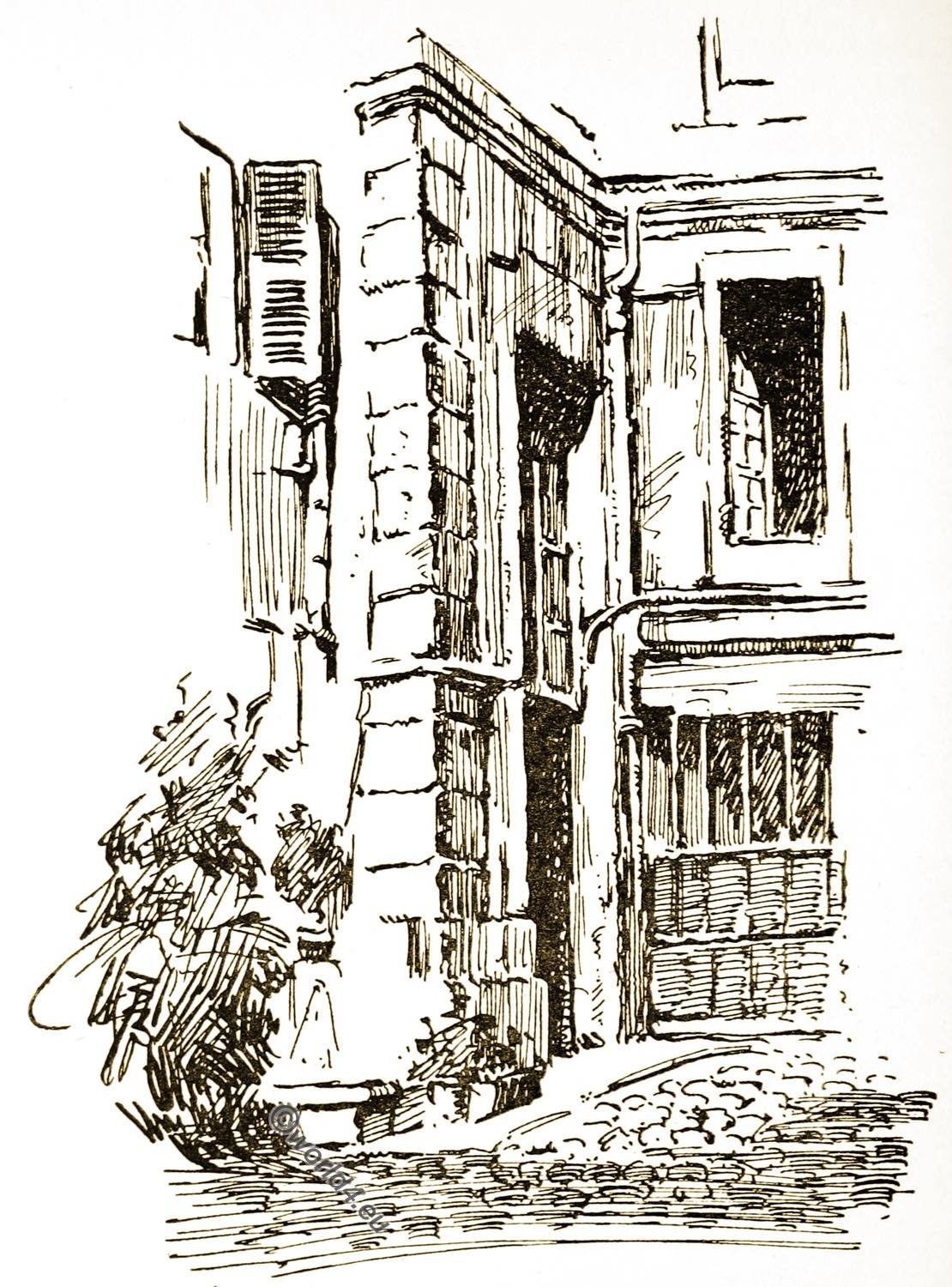
At the back of the Place des Vosges, once the centre and theatre of the life of the 17th century, runs the dingy Rue des Tournelles. In it stands the house where Ninon de Lenclos spent the long and brilliant years of her extraordinary career of pleasure. It was here also that she died.
One autumn day, a few years ago, curiosity led me to visit the place which holds so many memories of the beautiful courtesan. The Corinthian columns of the door stand back from the street in a moldy courtyard, the entrance is dilapidated and the handsome balustrade of the stone stairway has been removed. The concierge gave me the key, hoping to find a tenant in a visitor who seemed so eager; I mounted the steps, and stood at the door before which so many hearts have beaten wildly. Here was the little ante-room, in which Dukes, Marquises, even Princes of the Church, anxiously awaited the caprice of the coquette, who, be she sixteen or sixty, could equally charm, captivate, and enchain.
Source: Shadows of old Paris by Georges Duval (Georges-Louis-Jacques Labiche). London: F. Griffiths 1910.

Related
Discover more from World4 Costume Culture History
Subscribe to get the latest posts sent to your email.

